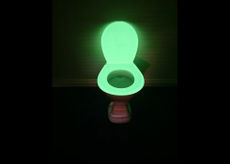Incandescent toilet seat
This article is being considered for deletion in accordance with Uncyclopedia's deletion policy
This article may not fit in Uncyclopedia, or may not be funny with little chance for redemption. Please share your thoughts on the matter at this article's entry on the Votes for deletion page. |
The incandescent toilet seat (ITS) is a variation of the standard porcelain collar intended to overcome many of the dangers and drawbacks of this common household sanitation fixture. It was popular in the mid 19th century, but experienced a rapid decline in the early 1920s following the invention of vindaloo.
Operation[edit | edit source]
Commonly known as the "Pacific Ring of Fire", the device functions by heating a tungsten seat ring to between 3,000°C and 6,500°C, thereby causing the seat to glow brightly. Doing so not only removes the need for an external light bulb, but also removes the danger of user discomfort caused by placing naked buttocks on a cold surface. Perhaps most importantly of all, the seat will instantly boil any bit of wees or poos that may have mysteriously landed on it, filling the air with their sweet, sweet vapour.
Invention and History[edit | edit source]
The original incandescent toilet seat was patented in 1854 by famous inventor duo Frances "Fanny" Burns and Richard Scalding. However, later discovery in 1861 of similar devices ceremonially buried with Cro-Magnon skeletons (circa 40,000 B.C.) in Southern France voided the "novelty" criterion of the patent before it could be fully commercialised by Burns and Scalding. This calamitous event lead to the outbreak of the American Civil War and so-called "War of the Ring" throughout the following two decades, during which the day's most powerful international toilet merchants, EA Games and Wendy's, vied for toilet-seat technological superiority. The battle only ended in 1872 when a truce was agreed, following massive independent research that showed both companies' products were suitable only to fill a lavatory, not to construct one.
Early versions of the device were heated by natural gas flame circulating in open half-pipes underneath the seat. However, this system led to a series of catastrophic flatulence explosions in Mexican restaurants and retirement villages, resulting in fatalities in the tens of thousands. Following the commercialisation of electricity in the late 19th century, the seats were typically sold in an electrically powered configuration.
The first electric system to be introduced in 1889, the Cyberdyne Systems Model 1, had a serious design flaw in which two live electric terminals were exposed near the front of the seat, often causing fatal electric shock to the testicles of users. This had a slight limiting effect on the commercial success of this model outside Australia, although eventually all were sold to Kaiser Wilhelm II for the German Army at the outbreak of World War One. The effectiveness of the system for torture and entertainment were legendary, and it can be seen on display at the Deutsches Museum in Munich to this day.
The ITS is also widely credited as being the inspiration for Thomas Edison's work in commercialising the original incandescent filament light bulb.
Criticism and Drawbacks[edit | edit source]
Criticism of the ITS began almost immediately upon its invention. However, critics' main claims — that the system was "stupid, dangerous, pointless, and a known cause of spastic perambulation" were soon silenced by lynch mob.
Other common complaints were:
Redness and inflammation of the buttocks — such claims were readily dismissed by manufacturers, who continuously stated that "proper" use of the seat would have no such effect. A major public court case held by one complainant brought the verdict of "The abovementioned symptoms are merely a consequence of your indecent lifestyle, sir" from the judge.
Excessive power consumption — While the 25 – 60kW power draw of common systems was indeed beyond the capabilities of most household electricity connections, it did spur the construction of larger-scale connections and was thus the indirect cause of the Industrial Revolution.
Coloured children born to white parents — This is commonly accepted to be unrelated to the use of ITS, although scientific studies have been divided.
Eyestrain — Irregular illuminance from the ring-shaped filament was known to cause eyestrain, wrinkles and Type 1 cross-eyedness; however, all suits claiming erectile dysfunction resulting from these factors have been dismissed by the court system.
Excessive heat — Many users complained that, while a toilet seat at 0°C is uncomfortably cold to sit on, heating it to 5,000°C is more than what is required to comfort the buttocks. Manufacturers have always maintained that a slight margin for excess is required to account for the wide variation in personal tastes, although a number of specialised "SensiTush" models have been released with temperatures as low as 2,500°C.
